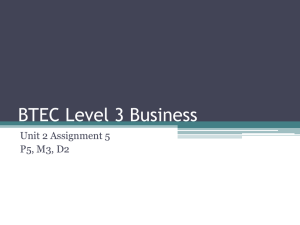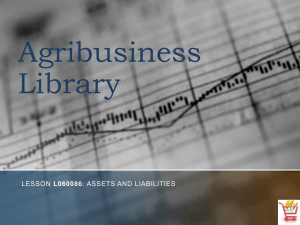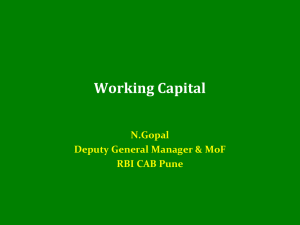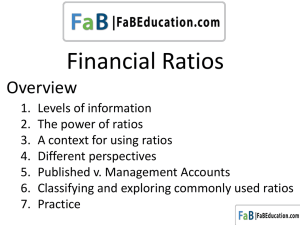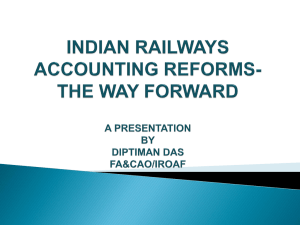Analysis of Financial Statements
advertisement
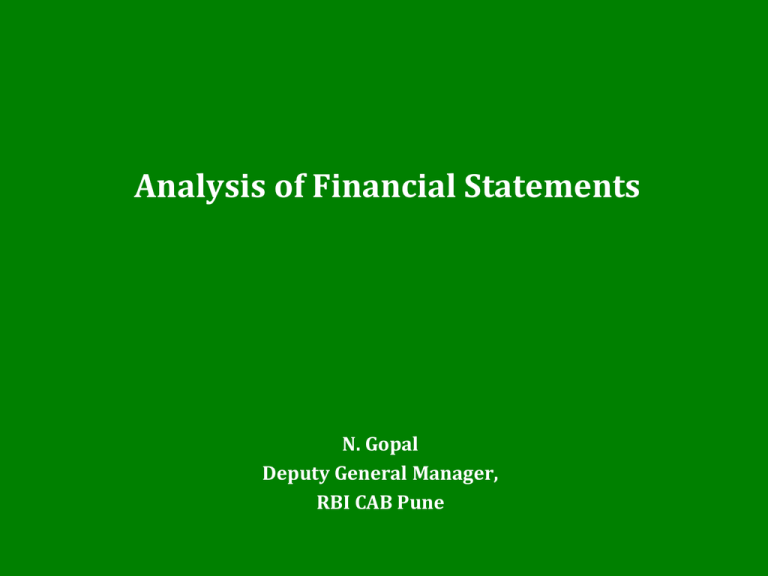
Analysis of Financial Statements N. Gopal Deputy General Manager, RBI CAB Pune Structure of the Presentation • • • • • • • What are Financial Statements Why Analyze them What do we see in them How do we analyze them What do we get to know Cash Flow Funds Flow Definition of Financial Statements • Financial Statements present a periodical view or reports on the progress by the Management. They present the status of investments in business as also the results achieved during a period. • They are a combination of recorded facts, accounting conventions and personal judgments. American Institute of Public Accounts Features of Financial Statements i. Periodical review of the status of investment and progress made by the Management ii. Facts recorded on the basis of accounting conventions and exercise of personal judgments. iii. Integrity and competence of accountants who prepare them have a vital bearing on the ultimate results furnished iv. Reliability, authenticity of the analysis would be just as much as that the of Financial Statements themselves. Weakness of Financial Statements • • • • Lack of objectivity Influenced by the subjective exercise of judgments Reliance on the intentions of the recorder Requires an external independent agency to certify its “true and fair view” • Non financial assets do not get recorded or reflected in financial statements Who analyzes them and why 1. Investors or provider of funds: – Whether the enterprise would be profitable- focus on returns or dividends- Profitability 2. Creditors: – Whether he would get his money back- repayment ability, interest servicing ability- Liquidity – Safety of funds lent, viability 3. Banker: – Safety of Funds lent, Yield, End-use of funds, viability 4. The enterprise itself: – Whether it would repay the external debts as well as carry on operations – Service the paid-up-share capital- good or comparable yield – Leave surplus to meet its growth needs Typical Balance sheet Sources of Funds (Liabilities) Uses of Funds (Assets) Share holders’ Funds (Paid-upCapital and Reserves) ………1 Factory, Land and Building Plant and Machinery ……..4 Term Liabilities (Debentures, Investments, Expansion of assets Bonds, long term borrowing from ……5 term lenders) ……2 Bank loans, Trade creditors and other liabilities …….3 Operating assets (cash, inventory, debtors receivables etc) …….6 Summary: Analysis of the financial Statement indicates and involves 1. Checking the investment (or deployment) of funds decision by the enterprise 2. Verifying the financing (funding) pattern proposed/in use by the enterprise 3. Examining the operating efficiency Banker and his interest in Financial Statement • Analysis of Financial Statement constitutes “back-bone of “good lending” Parameters taken must satisfy the criteria of “good lending” • What is “Good Lending” ? – Lending that takes care of the interest of the depositors or keeps depositors interest in mind. • Depositors interest ? (SLY) • Safety • Interest (Yield) • Ease or availability when needed (Liquidity) Analyses of Financial Statements should provide answers to the above questions. To instill confidence in depositors banker is also interested in knowing the “Purpose” What is seen in a balance sheet 1. Judicious investment of funds provided by owners and creditors Creation of useful assets 2. Do the assets by use yield sufficient returns to the providers after meeting all expenses and charges Assets capable of generating income 3. Whether there is surplus left to enable future growth and meet future claims on the enterprise. Ability to generate surplus for future growth Limitations of a Balance sheet 1. “Snap Shot of a Moving Train” 2. Static Statement of balances on a given date 3. Inexactness owing to personal bias or judgment – valuation of assets, provisions etc 4. Only the rupee or monetary value of all assets and liabilities reflected – no scope for factoring in “inflation”just historical costs 5. Exclusion of non-monetary but critical assets (human resources, strategic position, monopoly etc) 6. Dated- Open to Window Dressing 7. Does not give insight into process or movement of funds Overcoming the shortcomings • Examine a series of balance sheets or examine balance sheets of three to five years • Do not read balance sheet on ABSOLUTE terms but RELATIVE terms • Analyze the profit and loss account • Analyze Ratios • Analyze the Funds flow statement with the balance sheet • Analyze the cash flow statement with the balance sheet • Read the Auditors notes along with the figures in the Balance sheet Analyzing Ratios- Return on Capital Employed • Profit before Depreciation and Taxes / Total Capital Employed PBIT/Total Assets x100 • High Ratio indicates that business is Profitable • Indicates the Earning power of business • Measure of the Management’s skill in deploying or investing funds of the company • Reasonable or comparable returns – indication of continuation of business Operating profit ratio • Operating Profits/Net Sales x 100 • Indicates operating efficiency • Can be used to compare similar industries • Gives trend of performance over several periods Expenses ratio Expenditure x 100 Sales Net Profit after Tax x 100 Tangible Networth • Indicates Efficiency • As years go by Sales should increase without much increase in the Expenditure • Indicates profit earning capacity • High ratio means Owners funds have been invested profitably Liquidity Ratio Current Ratio Current Assets x 100 Current Liab. (Quick Ratio or Acid test Ratio) C.A- Inventory x100 C.L-Bank borrowings • Whether current assets are enough to cover current liabilities • Higher ratio could be bad or good • Lower ratio not necessarily bad • Whether current liabilities are funding current assets Solvency Ratio Total Outside Liabilities Tangible Networth Total term liabilities Tangible Networth or Debt Equity • Indicates Solvency • Indicates size of owners stake • Indicates stake of creditors • Indicates the coverage of liabilities by the net-worth • Lower ratio indicates greater solvency Other Ratios Retained Earnings x 100 Net Profit after tax • Indicates the plough back of profits into business • Higher ratio indicates prudence Dividend x 100 Net Profit • High ratio indicates large distribution of profits and lesser plough back Turnover Ratio Annual Sales x 100 Closing Stock • High ratio indicates good turnover of stock • Efficient management of sales • Low ratio indicator of large unsold stock Turnover Ratios cont…. Trade Creditors x 100 Average monthly Credit Purchases • Indicates the number of months credit received by the company • High ratio means that the creditors are willing to give more than normal credit • High ratio could also indicate that the company unable to service creditors on time • High ratio could be a warning signal Turnover Ratios cont…. Sundry debtors x 100 Average monthly Credit Sales • Indicates the number of months credit given by the company • High ratio means that the easy credit terms given by the company • High ratio could also indicate that the company unable to collect on time • High ratio could be a warning signal Turnover Ratios cont…. Raw Material stock x 100 Average monthly Consumption • High ratio indicates accumulated raw materials, slow production process, unusable materials, indiscreet buying and stocking, seasonal nature of raw materials • Trend over a period of time say 1 or 2 years to be seen to come to a conclusion Turnover Ratios cont…. Stock-in-process x 100 Average monthly Cost of production • High ratio indicates delayed process of manufacturing • High ratio also indicates complicated and time consuming process Turnover Ratios cont…. Finished Goods stock x 100 Average monthly Cost of sales • High ratio indicates unsalable items accumulating • High ratio could also mean over produced and stocked • High ratio also means no demand for the finished goods. Profitability ratios Net Profit after tax x 100 Total number of shares • Indicates the return available to shareholders • Dividend paying capacity of the company Profitability ratios Net Profit after tax x 100 Total Dividend Paid • Indicates dividend paid to the shareholders • Dividend payout ratio • Conversely the extent of retained earnings Ratios for Working Capital • Current Ratio • Solvency Ratio • Interest Coverage Ratio • Profit to Sales Ratio • Return on Capital Employed or Return on Assets • Turnover ratio (Inventory + Receivables)/Net Sales Some ratios explained • PBIT/Interest (Times) – Interest coverage ratio, explains how many times the firm earns to cover the interest payable by – Higher ratio means comfortable debt servicing capacity from cash accruals – A ratio of 3 or 4 is very comfortable. – A ratio of 2 could be risky • (Inventory + Receivables) / Net Sales – Expressed in days ratio captures turnover time for major current assets – Higher ratio indicates slower turn over and higher risk Ratios for Term loans • Project Debt to Equity Ratio • TOL/TNW • Gross Average Debt Service Coverage Ratio (Project) • Gross Average Debt Service Coverage Ratio (Company) Some Ratios Explained • Project Debt/Equity – The debt raised for the project vis-à-vis the equity – High leverage will be riskier if the environment were to turn adverse – Ratio indicates viability of the project under implementation • Gross Average DSCR (Project) PAT + Dep + non Cash expenses + interest on term loan for project Annual term loan installment + Interest on term loan – The cash accruals for the entire period of project to be taken and divided by the repayment obligation for the entire period Cash Flow Statement • • • • What is it ? What it tries to state How does one prepare it What are its limitations CASH FLOW What is Cash Flow Statement • Where from is cash generated in a business? • Do operating and regular activities of a business result in cash movement – in and out ? • Does cash movement arise from financing activities as well ? • Does investment activity result in cash movement ? • Cash is an important component in business and economic activity • A business entity needs cash to pay wages, procure materials, pay interest, dividends, pay for utility services “Cash is to business as blood is to human body” What is cash • A business may be earning profits or it may be profitable but it may not have cash to pay dividends !!!! • What message such a situation convey to the Stakeholders? • Improper cash management would result in the above situation • Cash Means: i. Cash in hand, ii. Demand deposits with the bank and iii. Cash Equivalents • Cash Equivalents Mean: Near Cash assets, such as Overdrafts, Cash Credits, Short term deposits and highly liquid and marketable securities Cash Flow Statement • A Statement which depicts the flow of cash in an organization- also includes cash equivalents. • The statements shows 1. How cash flows into and out of the organization 2. Ability of the organization to generate and utilize cash 3. Summary of receipts and disbursements of cash in an organization for a particular period of time 4. Gives reasons for change in cash position of an organization. Objective of Cash Flow Statement 1. Highlight the cash generated from various activities a firm undertakes 2. Helps in planning replacements of fixed assets, repayment of debt 3. Helps in Investment decisions 4. Indicate and evaluate the Liquidity of an enterprise 5. Acts as a cash management tool 6. Helps an organization understand the dynamics of cash movements How does cash flow arise 1. Operating Activities : Principal revenue generating activities of an organization such as sales, purchases, meeting expenses etc. (cash from operations) 2. Investing Activities: Activities involving acquisition and disposal of long term or capital assets– also includes non cash equivalents of investments (long term investments) ( cash from investments) 3. Financing Activities: Activities that result in change in size and composition of owners’ equity and long term borrowings. (cash from financing) To understand and arrive at the cash flow one has to look into 3 different areas of activities CASH IN OPERATING ACTIVITIES CASH INFLOW CASH OUTFLOW CASH SALE CASH FROM DEBTORS CASH FROM FEE COMMISSION CASH PURCHASES PAYMENT TO CREDITORS OPERATING EXPENSES PAYMENT OF WAGES OTHER CASH REVENUES PAYMENT OF TAXES Some operating activities resulting in cash flow • • • • • • • Cash receipts from sale of goods and rendering of service Cash receipts from royalties, fees, commission etc Cash payments to suppliers of goods and services Cash payment to employees, (salaries, wages ) Cash receipt from premiums Cash payment of premiums Cash refunds from income tax unless specially identified with financing or investing activities. Cash flows from operating activities are primarily from principal revenue generating activities. Result from transactions and other events that enter into the Profit and Loss Account CASH IN INVESTMENT ACTIVITIES CASH INFLOW CASH OUTFLOW Sale of Fixed Assets Sale of Investments and Securities Interest Income Dividend Income Purchase of Fixed Assets Investments Some investing activities resulting in cash flow • Cash payments to acquire fixed assets, self constructed fixed assets, intangibles • Cash receipts on disposal of fixed assets (plant and machinery, land and building) intangibles etc • Cash investments in shares • Cash receipts in disposal of shares • Cash advances and loans to third parties CASH IN FINANCING ACTIVITIES CASH INFLOW CASH OUTFLOW Issue of Shares Issue of Debentures Raising Long term Loans Retiring of Preference Shares Retirement of long term loans Interest on debentures Dividends paid on equity Some financing activities resulting in cash flow • Cash proceeds from issue of shares or similar capital instruments (raising of capital) • Cash proceeds from issue of Debentures, long term loans, bonds and other borrowings • Cash repayment of borrowings and loans Method of Preparing Cash Flow Statement • Direct Method – Only those items, which impact the cash, are taken for two years to compute the net cash flow • Indirect Method – The cash flow is worked out in a reverse direction by taking the profit figure FUNDS FLOW Funds Flow Statement ? • A summary of a firm’s changes in financial position of a business entity from one period to another; it is also called a sources and uses of funds statement or a statement of changes in financial position. Why Examine the Funds Flow ? • • • • • Financial Statements for a particular period do not give complete information- information is as on a particular date Where from funds came and how where they deployedis not answered. Includes important non-cash transactions while the cash flow statement does not. Is easy to prepare and often preferred by managers for analysis purposes over the more complex cash flow statement. Helps you to better understand the cash flow statement, especially if it is prepared under the “indirect method.” Four good reasons for funds flow statement 1. It explains the financial consequences of business operations: Gives answer to following conflicting situations. i. How the business could have good liquid position in spite of business making loses or acquisition of fixed assets? ii. Where have the profits gone? iii. How a business can earn more and more profits. 2. It answers intricate queries: i. How much fund is generated from normal business operations? ii. What are the sources of repayment of loans? iii. How to utilize the funds up to optimum level? Four good reasons for funds flow statement 3. It acts as an instrument for allocation of resources. 4. It is a test of effectiveness in use of working capital. Profit and Loss Account and Balance Sheet do not clearly provide complete and needed information What are Funds ? All of the firm’s investments and claims against those investments. Extends transactions involving beyond just cash. The letters labeling the boxes stand for Uses, Sources, Assets, and Liabilities (broadly defined). The pluses (minuses) indicate increases (decreases) in assets or liabilities. S U A + L + - Looking at the Balance Sheet A banker has to look at the Balance Sheet of the Borrower as a set of 5 BOXES Balance sheet for two periods A. Convert balance sheets of two consecutive years into 5 boxes. B. Work out the change in amounts in the boxes. C. The result of the change would be Funds flow statement Preparation of Funds Flow statement A. Take balance sheets as at two dates covering the period for which fund flows statement is intended to be prepared. B. Work out increase /decrease in each of items C. Classify change in each item under any of the four heads: (1) Long term sources (2) Long term uses (3) Short term sources (4) Short term uses. D. The deficit or the surplus in the long term category will be equal to the surplus or deficit in the short term category. Funds Flow and Assets and Liabilities • Changes in assets and liabilities lead to inflows or outflows Funds • Increase or decrease in assets liabilities does not always lead to changes in funds flow e.g. Depreciation or revaluation • All increases/decreases need not necessarily impact funds flow and hence has to be removed from funds flow statement Transactions not impacting funds flow Preparation of Funds flow • When preparing fund flow statement the non-fund based adjustments have to be nullified in order to capture only those changes in the values of assets and liabilities that are accompanied by flows of fund. • Increase in the item "reserves and surplus" indicate the amount of retained profits for the year. • Adding profits distributed to this figure we will get the amount of net profit for the year after taxes. • The net profit figure needs to be adjusted for all non-cash expenses and noncash incomes. Preparation of Funds Flow • • • • Rule: Add all non-cash expenditure to the profits Deduct all non-cash income from the figure of net profit. Add Depreciation to the change in reserve and surplus and correspondingly to the value of assets concerned. • Deduct: The appreciation. • Add: Add the amount of write offs to net profits. • Income accrued but not received Expenses accrued but not paid need not be excluded from the Funds Flow statement Transactions that affect funds flow 1. Transactions that effect current and fixed assets. A transaction, which changes the balance of current assets and fixed asset, will make a flow of funds. 2. Transactions effecting current assets and non-current liabilities. When a transaction effects a change in current asset and non-current liability, it will result in flow of funds. 3. Transactions effecting current liability and non-current assets. All those transactions, which involve current liabilities and non-current assets, will result in flow of funds. 4. Transactions effecting current liability and non-current liability: when there will be change in current liability and non-current liability will result in flow of funds. Transactions not impacting Funds Flow 1. If transaction effect accounts of current category only: All those transaction which effect the current assets or current liabilities only will never result into flow of funds. 2. If transaction effect non current accounts only. There will be no change in flow of funds, if a transaction affects accounts of non-current category only. In a nutshell Funds Flow Schedule of changes in WC Sources and Uses of Funds Funds from Operations Preparation of Funds Flow statement LIABILITIES CHANGE TYPE ASSETS CHANGE TYPE CAPITAL + LTS FIXED ASSETS + LTU RES. SURP. + + LTS INV. ASSOCT. LTU LTS INVENTORY + + SHORT TERM LOANS + STS DEBTORS + STU CREDITORS STS CASH AND BK. + STU C.L. + + STS OTHER C.A. + STU OTHER LIAB. + STS ADV. TO SUPPLIERS + STU LONG TERM LOANS STU Preparation of Funds Flow First Step to Preparation The Final Statement THANK YOU





